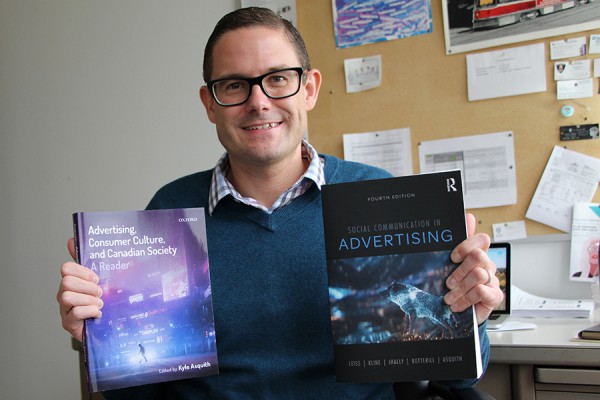 It has been a big year on the publishing front for UWindsor professor Kyle Asquith.
It has been a big year on the publishing front for UWindsor professor Kyle Asquith.
The authors of Social Communication in Advertising are rock stars in the world of communication studies. Now, the University of Windsor’s Kyle Asquith is one of those celebrities, too.
Dr. Asquith, an associate professor in the Department of Communications, Media and Film and assistant dean in the Faculty of Arts, Humanities and Social Science, has revised what is considered an essential text for students around the globe. He wrote new chapters and updated the existing material to make it more relevant to the current media environment, all in time for this fourth edition to become required reading for communication studies and sociology students this semester.
The authors’ names are “synonymous with critical advertising studies,” Asquith said, explaining he was in kindergarten when the first edition was published in 1986. He said he first encountered the text in his undergraduate years and cited it in his Master’s and doctoral work.
“It’s truly an honour to have my name attached to this classic.”
It has been a big year on the publishing front for Asquith, who joined the campus in 2012. He also put out Advertising, Consumer Culture & Canadian Society: A Reader. Through 16 chapters, each written by different scholars, the collection explores the connections between advertising and Canada’s national psyche.
One chapter delves into why Tim Hortons is tied to Canadian nationalism. Another looks at Hudson’s Bay Company’s branding as a message of colonialism and symbolic annihilation of Indigenous history. Yet another examines how Canadian department stores were sites for race and class divides.
“It’s unique for being Canadian,” Asquith said of the book. “There was never a Canadian alternative.”
Until now, students learning about advertising in a cultural context had to be content reading about Nike and Budweiser. Asquith’s new collection instead contains chapters on Canadian-founded companies Molson, Lululemon and MAC Cosmetics.
While Asquith began working on the collection about two years ago, he wrote a chapter of his own and completed Social Communication in Advertising last year while he held a Humanities Research Group fellowship.
—Sarah Sacheli
